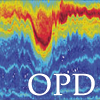
|
Laura Crews Research Assistant lcrews@apl.uw.edu Phone 206-543-1845 |
|
Publications |
2000-present and while at APL-UW |
Wind-driven motions of the ocean surface mixed layer in the Western Arctic Brenner, S., J. Thomson, L. Rainville, L. Crews, and C. Lee, "Wind-driven motions of the ocean surface mixed layer in the Western Arctic," J. Phys. Oceanogr., 53, 1787-1804, doi:10.1175/JPO-D-22-0112.1, 2023. |
More Info |
12 Apr 2023 |
|||||||
|
Observations of sea ice and the upper ocean from three moorings in the Beaufort Sea quantify atmosphere-ice-ocean momentum transfer, with a particular focus on the inertial-frequency response. Seasonal variations in the strength of mixed layer (ML) inertial oscillations suggest that sea ice damps momentum transfer from the wind to the ocean, such that the oscillation strength is minimal under sea ice cover. In contrast, the net Ekman transport is unimpacted by the presence of sea ice. The mooring measurements are interpreted with a simplified one-dimensional ice-ocean coupled "slab" model. The model results provide insight into the drivers of the inertial seasonality: namely, that a combination of both sea ice internal stress and ocean ML depth contribute to the seasonal variability of inertial surface currents and inertial sea ice drift, while under-ice roughness does not. Furthermore, the importance of internal stress in damping inertial oscillations is different at each moorings, with a minimal influence at the southernmost mooring (within the seasonal ice zone) and more influence at the northernmost mooring. As the Arctic shifts to a more seasonal sea ice regime, changes in sea ice cover and sea ice internal strength may impact inertial-band ice-ocean coupling and allow for an increase in wind forcing to the ocean. |
|||||||||
Direct observations of the role of lateral advection of sea ice meltwater in the onset of autumn freeze up Crews, L., C.M. Lee, L. Rainville, and J. Thomson, "Direct observations of the role of lateral advection of sea ice meltwater in the onset of autumn freeze up," J. Geophys. Res., 127, doi:10.1029/2021JC017775, 2022. |
More Info |
1 Feb 2022 |
|||||||
|
In seasonally ice-free parts of the Arctic Ocean, autumn is characterized by heat loss from the upper ocean to the atmosphere and the onset of freeze up, in which first year sea ice begins to grow in open water areas. The timing of freeze up can be highly spatially variable, complicating efforts to provide accurate sea ice forecasting for marine operations. While melt season anomalies can be used to predict freeze up anomalies in some parts of the Arctic, this one-dimensional view merits further examination in light of recent work demonstrating the importance of three-dimensional flows in setting mixed layer properties in marginal ice zones. In this study, we show that horizontal advection of sea ice meltwater hastens freeze up in areas distant from the ice edge. We use nearly 800 temperature and salinity profiles along with satellite imagery collected in the central Beaufort Sea in autumn 2018 to document the roughly 100 km advection of a cold and fresh surface meltwater layer over several weeks. After the meltwater arrived, the mixed layer was cooler and shallower than the mixed layer in adjacent areas unaffected by the meltwater. The cooler and shallower meltwater-influenced mixed layer promoted earlier ice formation. Within the meltwater-affected area, advection was nearly as important as heat loss to the atmosphere for seasonally integrated mixed layer heat loss. |
|||||||||
Properties and dynamics of mesoscale eddies in Fram Strait from a comparison between two high-resolution ocean–sea ice models Wekerle, C., T. Hattermann, Q. Wang, L. Crews, W.-J. Von Appen, and S. Danilov, "Properties and dynamics of mesoscale eddies in Fram Strait from a comparison between two high-resolution ocean–sea ice models," Ocean Sci., 16, 1225-1246, doi:10.5194/os-16-1225-2020, 2020. |
More Info |
23 Oct 2020 |
|||||||
|
Fram Strait, the deepest gateway to the Arctic Ocean, is strongly influenced by eddy dynamics. Here we analyse the output from two eddy-resolving models (ROMS – Regional Ocean Modeling System; FESOM – Finite-Element Sea-ice Ocean Model) with around 1 km mesh resolution in Fram Strait, with a focus on their representation of eddy properties and dynamics. A comparison with mooring observations shows that both models reasonably simulate hydrography and eddy kinetic energy. Despite differences in model formulation, they show relatively similar eddy properties. The eddies have a mean radius of 4.9 and 5.6 km in ROMS and FESOM, respectively, with slightly more cyclones (ROMS: 54%, FESOM: 55%) than anticyclones. The mean lifetime of detected eddies is relatively short in both simulations (ROMS: 10 d, FESOM: 11 d), and the mean travel distance is 35 km in both models. More anticyclones are trapped in deep depressions or move toward deep locations. The two models show comparable spatial patterns of baroclinic and barotropic instability. ROMS has relatively stronger eddy intensity and baroclinic instability, possibly due to its smaller grid size, while FESOM has stronger eddy kinetic energy in the West Spitsbergen Current. Overall, the relatively good agreement between the two models strengthens our confidence in their ability to realistically represent the Fram Strait ocean dynamics and also highlights the need for very high mesh resolution. |
|||||||||






